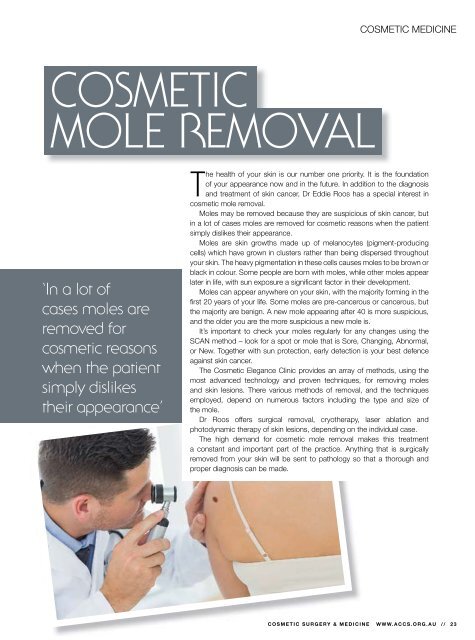Create successful ePaper yourself
Turn your PDF publications into a flip-book with our unique Google optimized e-Paper software.
COSMETIC MEDICINE<br />
COSMETIC<br />
MOLE REMOVAL<br />
‘In a lot of<br />
cases moles are<br />
removed for<br />
cosmetic reasons<br />
when the patient<br />
simply dislikes<br />
their appearance’<br />
The health of your skin is our number one priority. It is the foundation<br />
of your appearance now and in the future. In addition to the diagnosis<br />
and treatment of skin cancer, <strong>Dr</strong> <strong>Eddie</strong> <strong>Roos</strong> has a special interest in<br />
cosmetic mole removal.<br />
Moles may be removed because they are suspicious of skin cancer, but<br />
in a lot of cases moles are removed for cosmetic reasons when the patient<br />
simply dislikes their appearance.<br />
Moles are skin growths made up of melanocytes (pigment-producing<br />
cells) which have grown in clusters rather than being dispersed throughout<br />
your skin. The heavy pigmentation in these cells causes moles to be brown or<br />
black in colour. Some people are born with moles, while other moles appear<br />
later in life, with sun exposure a signifi cant factor in their development.<br />
Moles can appear anywhere on your skin, with the majority forming in the<br />
fi rst 20 years of your life. Some moles are pre-cancerous or cancerous, but<br />
the majority are benign. A new mole appearing after 40 is more suspicious,<br />
and the older you are the more suspicious a new mole is.<br />
It’s important to check your moles regularly for any changes using the<br />
SCAN method – look for a spot or mole that is Sore, Changing, Abnormal,<br />
or New. Together with sun protection, early detection is your best defence<br />
against skin cancer.<br />
The <strong>Cosmetic</strong> Elegance Clinic provides an array of methods, using the<br />
most advanced technology and proven techniques, for removing moles<br />
and skin lesions. There various methods of removal, and the techniques<br />
employed, depend on numerous factors including the type and size of<br />
the mole.<br />
<strong>Dr</strong> <strong>Roos</strong> offers surgical removal, cryotherapy, laser ablation and<br />
photodynamic therapy of skin lesions, depending on the individual case.<br />
The high demand for cosmetic mole removal makes this treatment<br />
a constant and important part of the practice. Anything that is surgically<br />
removed from your skin will be sent to pathology so that a thorough and<br />
proper diagnosis can be made.<br />
COSMETIC SURGERY & MEDICINE WWW.ACCS.ORG.AU // 23


















